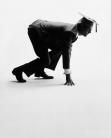Cerebral Cortex
Cerebral Cortex :
The very elaborate cerebral cortex is layered sheet some 2.5mm thick of literally billions of nerve cells that go over and around the brain. It covers the upper and outer portions of the brain called the cerebrum. This is why it is called the cerebral cortex. The cortex is wrinkled and folded. This convoluting greatly enlarges the surface area available, compared to a similarly sized smooth cortex.
The cerebrum is divided down the middle from front to back into two halves…the right and the left cerebral hemispheres. Each hemisphere controls the activities of the opposite side of the body that is, the left cerebral hemisphere controls the right side of the body and the right hemisphere controls the left side. Although in many ways the two hemispheres are mirror images of one another, there are functional distinctions between them. In most people, the areas that control the development and use of language are located in the left hemisphere while areas that govern three-dimensional visualization and musical and artistic creation are located in the right hemisphere.
Each hemisphere of the cerebrum is divided into four sections…the frontal, parietal (top rear), temporal (lower) and occipital (rear) lobes. The back part of the frontal lobe contains areas that govern movement of the opposite side of the body. Damage to this region results in paralysis. In front of this region is an area of the frontal lobe called the premotor cortex, where complex movements are controlled? Still farther forward is the prefrontal cortex, which exerts an inhibitory control over actions. Such distinctly human abilities as foreseeing the consequences of an action, exercising self-restraint and developing moral and ethical standards depend on the normal functioning of the prefrontal cortex. The parietal lobe, the part of the hemisphere that lies behind the frontal lobe, contains the primary sensory cortex the part of the brain. It receives sensory information from the opposite side of the body. Below the frontal and parietal lobes is the temporal lobe which is involved with hearing and memory. Behind the temporal lobe is the occipital lobe, the visual center of the brain. Here the signals that come to the brain from the eyes are put through very complex transformations in a process of analysis and integration.
Cranial nerves are a group of 12 pairs of sensory, motor or mixed (having separate sensory and motor fibers) nerves that connect with the brain stem and the lower parts of the brain.
More Essays on Philosophy
Cerebral Cortex :
Cerebral Cortex To HOME PAGE

Related Links : Cerebral Cortex